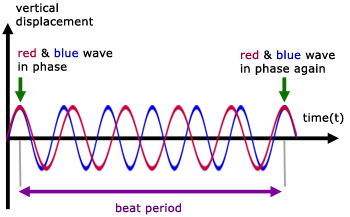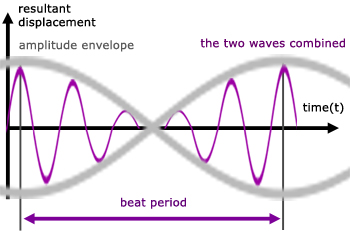Home >> Waves, beats
description |
Description
Beats is a phenomenon associated with sound waves, though the effect applies to all waves.
Essentially, when two similar frequencies ( f1 , f2) are sounded, a third much lower frequency is heard at the same time.
This third frequency is called the beat frequency ( fB ).
The beat frequency is simply the difference between the two original frequencies.
![]()
The beat frequency is measured from the rise and fall in the loudness/volume.
There is yet another frequency, the combined frequency( fC). This is the result of superposition of the two original frequencies. The combined frequency is simply the average of these frequencies.
![]()
Since the frequencies f1 , f2 are almost the same, the change in frequency to fC is hardly noticeable.
An example of the effect is the sound from a twin engined prop. aircraft. There is a periodic 'wow' or 'drone' noise produced as a result of the change in r.p.m. from the different propeller blades.
Explanation

The effect is a result of superposition of two sound wave frequencies producing a succession of constructive and distructive interference.
When the two frequencies are in phase they add, producing a wave with double the amplitude.
When the two waves are out of phase, they destroy eachother.

Theory
Consider our two original frequencies f1 and f2.
In time t the number of cycles completed by each frequency is f1t and f2t (no. cycles = no cyles per second x no. seconds).
Let us choose the time t such that the first wave completes one more cycle than the second.
![]()

From the first of two images (above), t is the time interval between the waves being in phase with each other.
So t is the beat period T (time for one complete 'beat' wave).

For any wave, period and frequency are inversely proportional to one another.
So for beat period T and beat frequency fB ,

hence, by similarity between the last two equations,
![]()
assuming f1 > f2
Measuring an unknown frequency
The method is to use a frequency( fU ), where only an approximate value is known.
This is used with a known frequency( fK ) close to the approximate value of fU to produce beats.
The beat frequency ( fB ) is given by:
![]()
or (depending on the relative magnitudes of fK and fU )
![]()
bringing the two equations together,
![]()
This is quite an accurate method, achieving results of 0.01% accuracy.
this week's promoted video
[ About ] [ FAQ ] [ Links ] [ Terms & Conditions ] [ Privacy ] [ Site Map ] [ Contact ]
